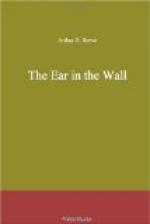“Well, the shadow in this picture can be made to prove an alibi for someone. Notice. It is seen prominently to the right, and its exact location on the house is an easy matter. The identification of the gable casting the shadow ought to be easy. To be exact, I have figured it out as 19.62 feet high. The shadow is 14.23 feet down, 13.10 feet east, and 3.43 feet north. You see, I am exact. I have to be. In one minute it moves 0.080 feet upward, 0.053 feet to the right, and 0.096 feet in its apparent path. It passes the width of a weatherboard, 0.37 foot, in four minutes and thirty-seven seconds.”
Kennedy was talking rapidly of data which he had derived from the study of the photograph as from plumb line, level, compass, and tape, astronomical triangle, vertices, zenith, pole, and sun, declination, azimuth, solar time, parallactic angles, refraction, and a dozen other bewildering terms.
“In spherical trigonometry,” he concluded, “to solve the problem three elements must be known. I know four. Therefore, I can take each of the known, treat it as unknown, and have four ways to check my result. I find that the time might have been either three o’clock, twenty-one minutes and twelve seconds in the afternoon, or 3:21:31 or 3:21:29, or 3:21:33. The average is 3: 21:26 and there can be no appreciable error except for a few seconds. I tell you that to show you how close I can come. The important thing, however, is that the date must have been one of two days, either May 22 or July 22. Between these two dates we must decide on evidence other than the shadow. It must have been in May, as the immature condition of the foliage shows. But even if it had been in July, that would be far from the date you allege. Why, I could even tell you the year. Then, too, I could look up the weather records and tell something from them. I can really answer, with an assurance and accuracy superior to the photographer himself, if you could produce him and he were honest, as to the real date. The original picture, aside from being doctored, was actually taken last May. Science is not fallible, but exact in this matter.”
Kennedy felt that he had scored a palpable hit. Dorgan was speechless. Still, Craig hurried on.
“But, you may ask, how about the automobile picture? That also is an unblushing fake. Of course I must prove that. In the first place you know that the general public has come to recognize the distortion of a photograph as denoting speed. A picture of a car in a race that doesn’t lean is rejected. People demand to see speed, speed, more speed, even in pictures. Distortion does indeed show speed, but that, too, can be faked.
“Almost everyone knows that the image is projected upside down by the lens on the plate, and that the bottom of the picture is taken before the top. The camera mechanism admits light, which makes the picture, in the manner of a roller blind curtain. The slit travels from the top to the bottom and, the image on the plate being projected upside down, the bottom of the object appears on the top of the plate. For instance, the wheels are taken before the head of the driver. If the car is moving quickly, the image moves on the plate and each successive part is taken a little in advance of the last. The whole leans forward. By widening the slit and slowing the speed of the shutter, there is more distortion.




